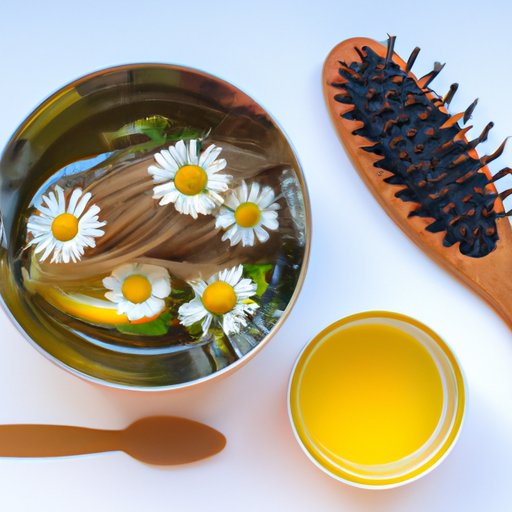
Introduction
Many individuals desire lighter hair, but they don’t want to use harsh chemicals that can damage the hair. Natural hair lightening techniques are a gentler, safer way to achieve a lighter look. This article will provide tips and recipes for natural hair lightening, as well as precautions to take and advice on maintaining hair health.
Lemon Juice
Lemon juice is a classic natural hair lightening ingredient. Its acidity can remove pigment from the hair shaft, leading to lighter hair. To lighten hair using lemon juice, mix equal parts fresh lemon juice and water in a spray bottle. Spray the mixture onto dry or damp hair, focusing on the areas you want to lighten. Sit in the sun for 30 minutes to an hour to activate the treatment, then rinse out with warm water.
While lemon juice can be an effective natural hair lightener, it can also cause dryness and damage. To avoid this, only use lemon juice treatments once per week and always follow up with a deep conditioning treatment. Be careful not to get lemon juice in your eyes or on your skin, as it can cause irritation.
Honey
Honey is another natural ingredient that can aid in hair lightening. It contains a small amount of hydrogen peroxide, which can lighten hair over time. To create a honey hair lightening treatment, mix two tablespoons of honey with two tablespoons of water. Apply the mixture to damp hair and let it sit for an hour. Rinse out with warm water and shampoo as usual.
Honey is a moisturizing ingredient, so it can be a good choice for those with dry or damaged hair. Still, it’s important to note that honey can also be a sticky, messy ingredient to work with. Be sure to properly dilute it and rinse it out thoroughly to avoid any stickiness.
Chamomile Tea
Chamomile tea can give your hair a lighter, brighter look. It contains compounds that can help lighten hair over time. To use chamomile tea as a natural hair lightener, brew a strong pot of chamomile tea and let it cool. Pour the tea over damp hair and let it sit for 30 minutes to an hour. Rinse out with warm water and shampoo as usual.
Chamomile tea is a gentle and natural ingredient, but it may not be as effective as lemon juice or honey treatments. It’s also important to be cautious when using chamomile tea on blonde hair, as it can cause a brassy effect.
DIY Hair Lightening Recipes
There are a variety of natural ingredients that can help lighten hair. Some popular options include apple cider vinegar, cinnamon, baking soda, and hydrogen peroxide. To create a DIY hair lightening treatment, mix your chosen ingredient with water or conditioner to dilute it. Apply the mixture to damp hair and let it sit for 30 minutes to an hour. Rinse out with warm water and shampoo as usual.
While DIY hair lightening treatments can be fun to experiment with, it’s important to be cautious. Overuse of natural ingredients can lead to dryness and damage. Always dilute your chosen ingredient and follow up with a deep conditioning treatment. It’s also important to do a patch test to check for any allergic reactions before applying the treatment to your whole head.
The Pros and Cons of Natural Hair Lightening vs. Going to a Salon
There are benefits and drawbacks to both natural hair lightening and salon hair lightening. Natural hair lightening is often gentler and safer for your hair, but it may take longer to achieve the desired result. Salon hair lightening can be more effective and efficient, but it also typically involves harsher chemicals that can cause damage if not done properly.
When deciding between natural hair lightening and salon hair lightening, it’s important to consider your hair’s health, your budget, and your desired outcome. If you have dry or damaged hair, natural hair lightening may be the better choice. If you want a more drastic change, salon hair lightening may be the way to go.
Tips for Keeping Hair Healthy When Lightening Hair Naturally
Regardless of which method you choose, it’s important to maintain hair health when lightening hair. Deep conditioning treatments can help to protect and moisturize hair that has been lightened. Regular trims can prevent split ends and breakage. Avoid using heat tools or harsh chemicals on lightened hair, as they can cause further damage.
Natural Ways to Lighten Different Hair Types
Different hair types may respond differently to natural hair lightening methods. curly hair, for example, can often be more delicate and prone to dryness, so it’s important to choose gentle, moisturizing ingredients. Fine hair may lighten more quickly, so it’s important to monitor the hair during the lightening process. Consult with a hair care professional if you’re unsure which natural hair lightening method is best for your hair type.
The Science Behind Natural Hair Lightening
The chemical processes that occur during natural hair lightening can be complex. Lemon juice, for example, contains citric acid, which can lift pigment from the hair shaft. Honey contains small amounts of hydrogen peroxide, which is a bleaching agent. Always research the ingredients you’re using to better understand how they work to lighten hair.
Before and After: Real-Life Transformations Using Natural Hair Lightening Techniques
Photos and stories of individuals who have successfully lightened their hair using natural ingredients can offer inspiration and guidance. Seek out social media accounts and blogs that feature before and after photos, and research the ingredients and methods used to achieve those results.
Conclusion
Natural hair lightening can be a fun and gentle way to achieve a lighter hair color. From lemon juice to chamomile tea, there are a variety of natural ingredients that can help lighten hair over time. However, it’s important to proceed with caution and always prioritize hair health. Consult with a hair care professional if you’re unsure which natural hair lightening method is best for your hair type.




